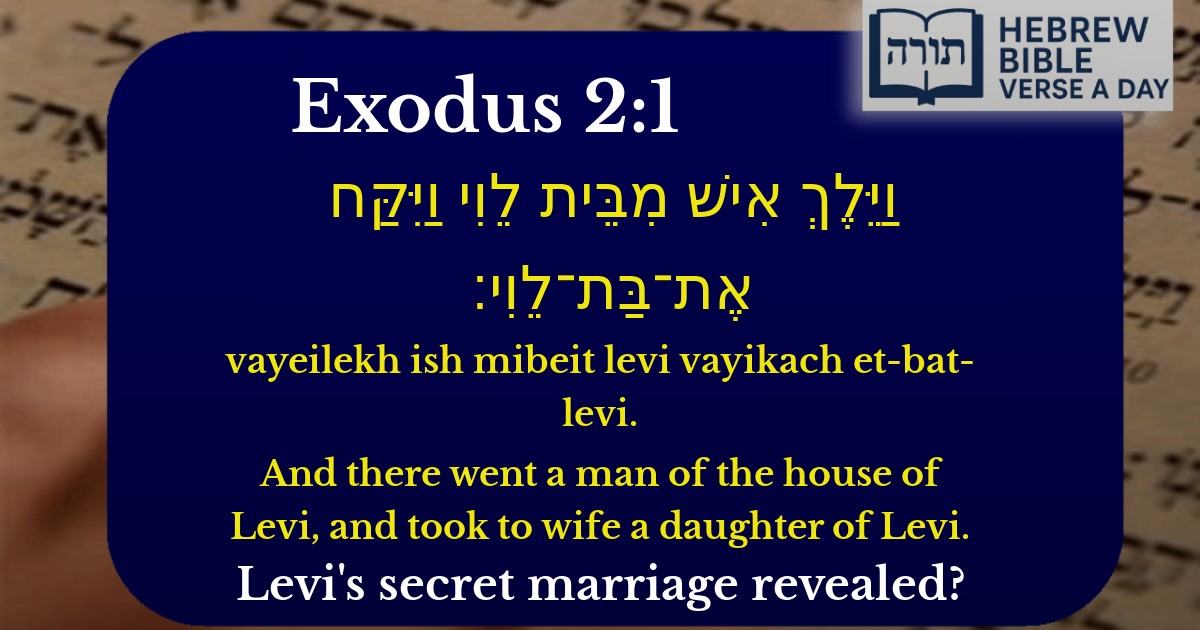Frequently Asked Questions
Q: Who are the 'man of the house of Levi' and the 'daughter of Levi' in Exodus 2:1?
A: According to Rashi and the Midrash (Shemot Rabbah 1:19), the 'man of the house of Levi' is Amram, the father of Moshe (Moses), and the 'daughter of Levi' is Yocheved, his mother. They were both from the tribe of Levi, showing the importance of lineage in the Torah.
Q: Why does the Torah mention that both parents were from the tribe of Levi?
A: The Talmud (Sotah 12a) explains that this emphasizes the righteousness of Moshe's parents. The tribe of Levi was known for not participating in the sin of the Golden Calf later on, and this verse hints at their spiritual strength. Ramban adds that their lineage was important because Moshe would become the leader of Israel.
Q: What lesson can we learn from Exodus 2:1 about marriage?
A: The verse teaches the importance of marrying within the Jewish people ('mishpacha,' family). Amram and Yocheved were both from the tribe of Levi, showing the value of shared values and heritage in building a Jewish home. The Midrash highlights that their union was blessed with Moshe, who would redeem Israel.
Q: Why does the Torah say 'there went a man' instead of just naming Amram?
A: Rashi explains that the phrase 'there went' suggests that Amram followed righteous advice. Earlier, he had separated from his wife due to Pharaoh's decree against Jewish babies, but after his daughter Miriam persuaded him (as mentioned in the Talmud, Sotah 12a), he 'went' back to do the right thing by remarrying Yocheved.
Q: How does this verse connect to the story of Moshe's birth?
A: This verse sets the stage for Moshe's birth (Exodus 2:2). The Midrash (Shemot Rabbah 1:19) teaches that their marriage was divinely destined to produce the future redeemer of Israel. Despite Pharaoh's decrees, Hashem ensured that the parents of the savior would come together at the right time.


Context and Background
The verse (Shemot 2:1) introduces the parents of Moshe Rabbeinu, who would later become the leader of Bnei Yisrael and receive the Torah at Har Sinai. The phrasing "a man of the house of Levi" and "a daughter of Levi" is intentionally vague, leading to various interpretations in Chazal.
Rashi's Commentary
Rashi (based on Sotah 12a) explains that this refers to Amram and Yocheved, who were already married but had separated due to Pharaoh's decree to drown all male infants. Amram remarried Yocheved after his daughter Miriam rebuked him, arguing that his separation was worse than Pharaoh's decree since it prevented even female children from being born.
Midrashic Insights
The Midrash (Shemot Rabbah 1:19) elaborates that Amram was the leader of his generation, making their reunion a public act of defiance against Pharaoh. The phrase "וַיִּקַּח" ("and he took") suggests he conducted a formal marriage ceremony (kiddushin) anew, emphasizing the sanctity of their union.
Rambam's Perspective
In Hilchos Issurei Biah (19:12), Rambam cites this verse to teach that even in exile, maintaining proper family structure is essential. The Levites' adherence to marital purity in Egypt merited their descendants' role in the Mishkan service.
Symbolism and Lessons